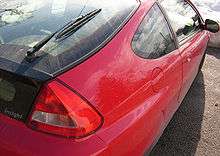Super ultra-low emission vehicle
Super ultra-low emissions vehicle (SULEV) is a U.S. classification for passenger vehicle emissions. The classification is based on producing 90% less emissions than an equivalent gasoline-powered vehicle.[1] SULEV is a stricter standard than LEV (Low Emission Vehicle) and ULEV (Ultra-Low Emissions Vehicle), however not as strict as PZEV (Partial Zero Emission Vehicle).[2]
Examples

Examples of vehicles delivering SULEV emissions performance include:
- Honda Accord 2000-? [3]
- Honda Insight (CVT transmission models only)[4]
- Honda Civic Hybrid CVT transmission models only, AT-PZEV available in certain states[5]
- Honda Civic GX Natural Gas
- Toyota Prius[1]
- Ford Focus SULEV [6]
- BMW SULEV 128i, 328i, 325i, 325Ci, and 325iT[7]
- Subaru PZEV Vehicles beginning with 2008 year models including Forester, Outback and Legacy[8]
- Chevrolet Volt[9]
- Hyundai Elantra[10]
- Lexus CT200h
- Kia Forte
- Volkswagen Jetta[11]
- Mini Cooper Hardtop 4-Door [12]
- Toyota RAV4 Hybrid[13]
Tax incentives
In California, manufacturers of SULEVs can be given a partial credit for producing a Zero Emission Vehicle (ZEV) and so a vehicle of this type can be administratively designated as a Partial Zero-Emission Vehicle (PZEV). In order to qualify as a PZEV, a vehicle must meet the SULEV standard and, in addition, have zero evaporative emissions from its fuel system plus a 15-year/150,000 mi (241,402 km) warranty on its emission-control components.
In the case of hybrid vehicles this warranty is extended to the electric propulsion components (electric motor/generator/starter, battery, inverter, controls) and their mechanical interface to the driveline - potentially a distinct advantage to the owner of such vehicle.
See California AB 1493 .
References
- 1 2 http://alternativefuels.about.com/od/glossary/g/SULEV.htm
- ↑ http://reviews.cnet.com/4520-11297_7-6729563-5.html
- ↑ http://www.honda.com/newsandviews/article.aspx?id=280-en
- ↑ http://www.insightcentral.net/KB/compare/emissions.html
- ↑ http://world.honda.com/news/2003/4030612.html
- ↑ https://media.ford.com/content/fordmedia/fna/us/en/asset.download.document.pdf.html/content/dam/fordmedia/North%20America/US/2015_Specs/2015_Focus_Specs.pdf
- ↑ http://consumerguideauto.howstuffworks.com/2011-bmw-3-series-4dr-sdn-328i-xdrive-awd-sulev.htm
- ↑ http://drive2.subaru.com/Fall08/Fall08_whatmakes.htm
- ↑ http://www.greencarcongress.com/2011/11/volt-20111117.html
- ↑ http://www.thedailygreen.com/living-green/blogs/cars-transportation/5642
- ↑ http://www.vw.com/models/jetta/
- ↑ http://www.jdpower.com/cars/MINI/Cooper%20Hardtop%204%20Door/2016
- ↑ "2016 Toyota RAV4 Hybrid Product Information | Toyota". Retrieved 2016-10-03.
See also
- US emission standard
- Automaker
- California Air Resources Board
- Car dealership
- Ultra Low Emission Vehicle
- Partial Zero-Emissions Vehicle
- Zero-emission vehicle
External links
| Wikibooks has a book on the topic of: California AB 1493 |
- "University of California, Riverside Study Shows Accelerated Introduction of Super-Clean Cars Will Help Los Angeles Meet Federal Smog Standards by 2010" (Press release). University of California, Riverside. 23 September 2003. Retrieved 10 July 2011.
- "Climate Change Program". California Environmental Protection Agency. Retrieved 10 July 2011.
- "Los Angeles Green Vehicle List for Smog & Green House Gas Reductions - Updated December 2011" (PDF). Retrieved 5 January 2012.